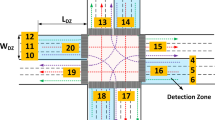Abstract
This paper presents an arterial green-wave synchronous coordination model for bus and non-bus lanes based on platoon dispersion theory. As the traffic light at an upstream intersection change from red to green, the dispersive characteristics of these vehicles moving from upstream to the downstream were analyzed by assuming velocities of two platoon following a normal distribution pattern. The model aims at analyzing relationship between traffic flow, distance between adjacent intersections, and signaling time in order to achieve arterial green-wave synchronous coordination in both the bus and non-bus lanes. To facilitate coordination in a traffic signal control system, the number of vehicles forced to stop at the head of the platoon as well as the number of vehicles trapped at the tail of the platoon were determined and presented in a tabular form for use in the proposed traffic light coordination model. Finally, a numeric computation for the coordination of successive signals is presented to illustrate the validity of the proposed model.













Similar content being viewed by others
References
Ma, D., Wang, D., Bie, Y., et al. (2013). A method of signal timing optimization for spillover dissipation in urban street networks. Mathematical Problems in Engineering, 2013(11), 1–11.
Yang, X., Wang, Q., Xue, H., et al. (2016). A coordinated signal control method for arterial road of adjacent intersections based on the improved genetic algorithm. Optik International Journal for Light and Electron Optics, 127(16), 6625–6640.
Yang, Z., Wang, W., Chen, S. Y., & Ding, H. Y. (2014). Setting methods of bus exclusive phase in bus green-wave control of urban arterial. Journal of Southeast University (Natural Science Edition), 4, 126–132.
Luo, K., Liu, Y. Y., Wu, H., & Huang, J. H. (2015). algebraic method of bidirectional green wave coordinated control under asymmetric traffic conditions. China Journal of Highway and Transport, 28(6), 23–28.
Wang, Z. W., & Zhang, P. (2011). Coordinated adaptive control for green wave coordinated control and transit signal priority. Systems Engineering, 39(3), 60–66.
Chen, J. D., Jiang, G. Y., Liu, B., & Huang, Z. F. (2015). Green wave coordinated control and simulation of bus lanes. Journal of Wuhan University of Technology (Transportation Science and Engineering), 4, 312–317.
Li, Z. L., Zhu, M. H., & Wang, H. J. (2015). A transit priority model for arterial roads based on the delays of upstream and downstream intersections. Journal of Transport Information and Safety, 5, 456–461.
Wang, J., Hu, J. J., & Li, F. (2013). Active coordinated control timing optimization algorithm of transit signal priority. Journal of Wuhan University of Technology (Transportation Science and Engineering), 37(4), 196–202.
Lin, Y. J., Yang, X. F., Zou, N., & Jia, L. (2013). New passive transit signal priority control strategy for the bus vehicles at urban arteries. Journal of Northeastern University (Natural Science), 39(4), 723–729.
Wang, D. H., Zhu, H., & Bie, Y. M. (2011). Bus signal priority method at arterial signal progression. Journal of Southeast University (Natural Science Edition), 41(4), 321–326.
Wang, B., Liu, X., Li, Y. G., & Jia, L. (2011). A method of public traffic signal priorty and verification based on coordination of trunk road. Journal of Highway and Transportation Research and Development, 28(S1), 36–39.
Bie, Y. M., Wang, D. H., Zhao, Y. Y., & Jia, L. (2011). Multiple-phase bus signal priority strategy for arterial coordination intersection. Journal of South China University of Technology (Natural Science Edition), 39(10), 78–85.
Bie, Y., Liu, Z., Lu, L., et al. (2015) A signal coordination algorithm for adjacent hook-turn intersections[J]. In Transportation research board annual meeting, pp. 76–82.
Bie, Y., Ma, D., Wang, L., et al. (2012). A signal coordination algorithm for two adjacent intersections based on approximate dynamic programming. Journal of Southeast University, 28(1), 345–346.
Robertson, D. (1969) I.TRANSYT-a traffic network study tool[M].RRL Report LR 253, Road Research Laboratory, UK.
Maher, M. A., et al. (2011). A comparison of the use of the cell transmission and platoon dispersion models in TRANSYT 13. Transportation Planning and Technology, 34(1), 71–85.
Liu, C. Q., & Yang, P. K. (1996). Diffusion models of traffic platoon on signal-intersection and control of coordinated signals. Journal of Tongji University, 24(6), 636–641.
Liu, C. Q., & Yang, P. K. (2001). Diffusion models of density of traffic platoon and signal coordinated control. China Journal of Highway and Transport, 14(1), 89–91.
Seddon, P. A. (1972). Another look at platoon dispersion: The recurrence relationship. Traffic Engineering and Control, 13(10), 442–444.
Shen, L. O., Jin, W. Z., & Wei, M. A. (2012). Platoon dispersion model considering the speed range limits. Journal of Jilin University (Engineering and Technology Edition), 42(6), 1465–1469.
Wei, M., Jin,W. Z., and Shen, L.O. (2012) A platoon dispersion model based on a truncated normal distribution of speed. Journal of Applied Mathematics, pp. 68–81.
Shen, L. (2015). Density-based mixed platoon dispersion modelling with truncated mixed Gaussian distribution of speed. Transportmetrica B, 3(2), 114–130.
Jiang, Y S., Yao, Z., Ding, X., et al. (2016) Mixed platoon flow dispersion model based on truncated mixed phase distribution of speed[C].In Transportation Research Board 2016 Meeting pp. 456–462.
Acknowledgement
This paper is funded by Jiangsu provincial government scholarship program;the National Natural Science Foundation of China (61503201);Natural Science Foundation of the Jiangsu Province in China (BK20161280); the Humanities and Social Sciences Foundation of the Ministry of Education in China(16YJCZH086);Natural Science Foundation of the Jiangsu High Education (15KJB580011); Nantong Science and Technology Innovation Program (GY12015025, GY12016019); Project of excellent graduate innovation in Hebei province(2016348).
Author information
Authors and Affiliations
Corresponding author
Rights and permissions
About this article
Cite this article
Wei, M., Sun, B. An Arterial Green-Wave Synchronous Coordination Model for Bus and Non-bus Lanes Based on Platoon Dispersion Theory. Wireless Pers Commun 95, 2091–2109 (2017). https://doi.org/10.1007/s11277-017-4040-7
Published:
Issue Date:
DOI: https://doi.org/10.1007/s11277-017-4040-7




